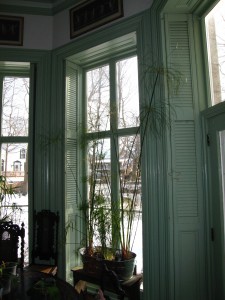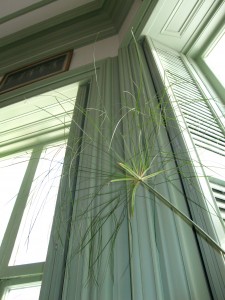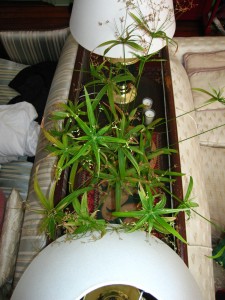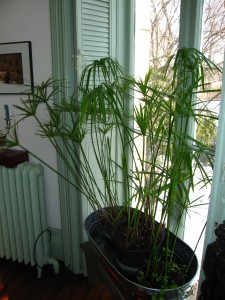In an earlier post this summer, I showed a few pics of 5 new papyrus plants I had acquired, with encouragement from my friend Kent Russell. In September, I moved them indoors ( a bit early, but I went travelling, I knew I wouldn’t be around to tend them outdoors). I have them in our 12′ tall south-facing windows, and they’re growing like crazy. Along with the great growth have come a couple of pest problems.

The Cyperus papyrus has exploded upwards to over 9′ tall. The previously needle-like leaves of earlier growths have been replaced by trifurcated strap-like fronds on the best stems. The weaker/older stems have been compromised by spider mites, which the newer growth is vigorously resisting. These mites showed up first on my Cyperus isocladus and soon spread to the neighboring Cyperus involucratus. I was able to keep up on the C. isocladus by scrupulously pinching and wping the mites from the leaves, but once it got into the hair-fine foliage of the C. involucratus I was forced to go another route.

I first introduced a vial of predatory mites into these plants. I’m not sure of the results of this; they couldn’t have hurt, but I didn’t wait for the predators to show domination before moving onto another avenue of attack. I began, (and continue) to twice-daily spray the plants with a fine misting of dilute colloidal cinnamon with a drop of Physan 20. This, I believe, is what has really done the trick.
The other pest in the pots has been those annoyingly ever-present fungus gnats. The solution has not been a difficult one, but in future I’ll attack it more vigorously and more thoroughly. The trick has been a combination of the aforementioned spray, Bacillus thuringiensis israelensis pellets in the pots and waterings, and yellow sticky-card traps. This attack has completely evicted the gnats from the papyrus. Unfortunately, the gnats have moved on to other plants around the house. From this, I’d recommend that anyone using BITS to control fungus gnats should go ahead and treat ALL the plants in their home, not just the obviously-infested ones.
A little later in the fall, friends dropped off three pots of Cyperus alternifolius. These are winter refugees from a summer pond, but had outgrown their previous owner’s capacity to winter them indoors. I cut all the drying summer growth completely back, and in less than a month have seen it all replaced with bright and vigorous indoor growth. Having come in from a pond, these three pots are ugly, unwieldy, and fully root-bound. Both these and the other plants have been placed into tubs in the window, half-filled with (very lightly) fertilized water.
The “other” papyrus, the Cyperus albostriatus has proven to dislike the growing conditions favored by the larger plants. While it certainly doesn’t like to be dry, neither does it like to be swamped. I have potted it into a nice 8″ clay picklepot with a more conventional watering scheme and am experimenting with differing placement around the house to see what it really prefers.

It’s been fun having them inside during the winter! The tall stems and firework-like heads are a great exotic contrast to the snowy scene beyond the windowpane. I can hardly wait to get them back outside for the summer where they belong and see how they really do!




Recent Comments